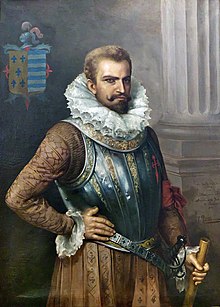
Back الغزو الإسباني للمايا Arabic Conquista española de los territorios mayas Spanish Penaklukan Maya oleh Spanyol ID Concista espaniol de la maias LFN مایا دی ہسپانوی فتح PNB مایا کی ہسپانوی فتح Urdu 西班牙对玛雅的征服 Chinese

The Spanish conquest of the Maya was a protracted conflict during the Spanish colonisation of the Americas, in which the Spanish conquistadores and their allies gradually incorporated the territory of the Late Postclassic Maya states and polities into the colonial Viceroyalty of New Spain. The Maya occupied the Maya Region, an area that is now part of the modern countries of Mexico, Guatemala, Belize, Honduras and El Salvador; the conquest began in the early 16th century and is generally considered to have ended in 1697.
Before the conquest, Maya territory contained a number of competing kingdoms. Many conquistadors viewed the Maya as infidels who needed to be forcefully converted and pacified, despite the achievements of their civilization.[2] The first contact between the Maya and European explorers came in 1502, during the fourth voyage of Christopher Columbus, when his brother Bartholomew encountered a canoe. Several Spanish expeditions followed in 1517 and 1519, making landfall on various parts of the Yucatán coast. The Spanish conquest of the Maya was a prolonged affair; the Maya kingdoms resisted integration into the Spanish Empire with such tenacity that their defeat took almost two centuries.[3] The Itza Maya and other lowland groups in the Petén Basin were first contacted by Hernán Cortés in 1525, but remained independent and hostile to the encroaching Spanish until 1697, when a concerted Spanish assault led by Martín de Urzúa y Arizmendi finally defeated the last independent Maya kingdom.
The conquest of the Maya was hindered by their politically fragmented state. Spanish and native tactics and technology differed greatly. The Spanish engaged in a strategy of concentrating native populations in newly founded colonial towns; they viewed the taking of prisoners as a hindrance to outright victory, whereas the Maya prioritised the capture of live prisoners and of booty. Among the Maya, ambush was a favoured tactic; in response to the use of Spanish cavalry, the highland Maya took to digging pits and lining them with wooden stakes. Native resistance to the new nucleated settlements took the form of the flight into inaccessible regions such as the forest or joining neighbouring Maya groups that had not yet submitted to the European conquerors. Spanish weaponry included crossbows, firearms (including muskets, arquebuses and cannon), and war horses. Maya warriors fought with flint-tipped spears, bows and arrows, stones, and wooden swords with inset obsidian blades, and wore padded cotton armour to protect themselves. The Maya lacked key elements of Old World technology such as a functional wheel, horses, iron, steel, and gunpowder; they were also extremely susceptible to Old World diseases, against which they had no resistance.
- ^ Lovell 2005, p. 58.
- ^ Jones 2000, p. 356.
© MMXXIII Rich X Search. We shall prevail. All rights reserved. Rich X Search